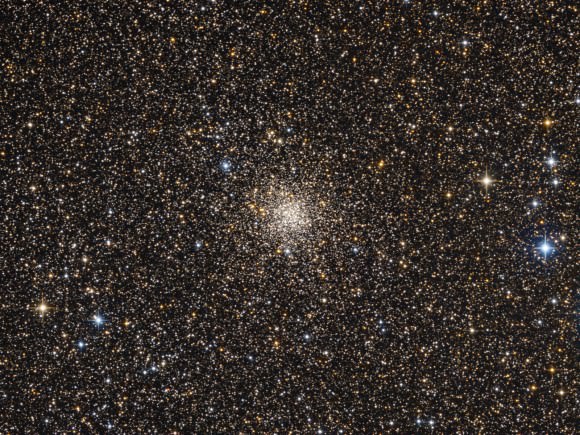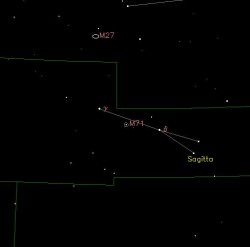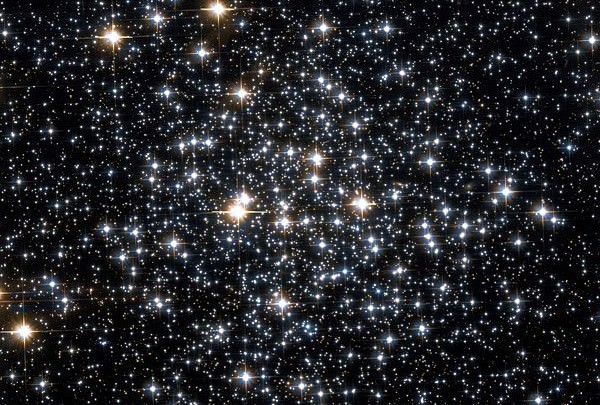[/caption]
In our rush to look at the bright and beautiful objects in the night, we often overlook celestial curiosities in favor of a more splashy neighbor. How many times have you looked at the Andromeda Galaxy, but really didn’t take the time to power up and study M110? Perhaps you spent a whole evening studying the intricacies of the Great Orion Nebula – but totally forgot about striking M78? It’s the way of things. But, next time you drop by the Dumbbell Nebula, spend some Hubl time with the sparkling stars of Messier 71…
Discovered by Philippe Loys de Cheseaux in 1746 and researched by Charles Messier then added his catalog of comet-like objects in 1780, this brilliant globular cluster let’s its presence be known at a distance of about 12,000 light years away from Earth. Covering an area measuring approximately 27 light years across, it shines with a luminosity of around 13,200 suns – not bad for a conglomeration of stars which could be as old as 9-10 billion years. Until about four decades ago, Messier 71 was believed to be a dense galactic cluster – nearly devoid of RR Lyrae “cluster” variable stars and rich in metallicity.
And a concentrated cluster of stars it stayed until modern H-R diagram photometry picked up a short “horizontal branch” in its structure…
Who remembers to stop and study? While grandiose images like our Hubble lead-in photo might pique your curiosity for a moment, it’s the deep sky dedication and devotion revealed in the work of Bernhard Hubl which ignites the sense of wonder all over again…

 Reach out and touch M71 for yourself. Located in the constellation of Sagitta at RA:19h 53m 48s Dec: +18°47′ and close to magnitude 7, it’s easily caught in average binoculars from a dark sky location, beauty revealed in smaller telescopes and breathtakingly resolved in large aperture telescopes. It’s really not hard to find if you just take the time to let your eyes relax to see Sagitta’s faint arrow-shaped signature asterism. Just aim mid-way between Gamma and Delta and be swept away…
Reach out and touch M71 for yourself. Located in the constellation of Sagitta at RA:19h 53m 48s Dec: +18°47′ and close to magnitude 7, it’s easily caught in average binoculars from a dark sky location, beauty revealed in smaller telescopes and breathtakingly resolved in large aperture telescopes. It’s really not hard to find if you just take the time to let your eyes relax to see Sagitta’s faint arrow-shaped signature asterism. Just aim mid-way between Gamma and Delta and be swept away…
Because it’s full of stars.
Many thanks go to Bernhard Hubl of Northern Galactic for his untold hours of work just to share the inspiration!


One minor nitpick, at the eighth line:
That should be lets, not “let’s” with an apostrophe — which is a contraction of “let us”.
Um… I’ll get my coat and see myself out…
Jeesh… thanks for the reminder Tammy. I can’t count the times I’ve shown off M27 and totally overlooked M71! Next Thursday, several of us are planning to ‘go up the mountain’ for a viewing of the Perseid Meteor shower, I will be SURE to include M71 in my list of views to be taken in!
It is my understanding that these clusters have older stars, and further they seem to be high metalicity stars. I have wndered about this from time to time. Does anyone have a quick explanation of that.
Globular clusters do have that look of being jewels on a black cloth.
LC
@ Lawrence B. Crowell,
I think that you may have your facts crossed. Globular clusters are generally composed of low-metal Population II stars similar to those found in the central bulge of spiral galaxies; however, Messier 71* is unusual in that it has stars with more ‘metals’ than most globular clusters. The shortness of the “horizontal branch” in the H-R diagram of M71 explains the lacking of the RR Lyrae variables and is due to the globular’s relatively young age of 9-10 billion years. The relative youth of M71 also explains the abundance of ‘metals’ in its stars.
*Source: Wikipedia — Messier 71.
I LIKE Globular Clusters! There are SO many visible in the night sky during the summer months that its hard to decide which ones to view first? Favorites include M13 in Hercules, because its SO easy to find and M54 in Sagittaurius because it is presumed to be the stripped core of the Sag. Dwarf Galaxy! Then there’s M4 in Scorpio, one of the nearest globular clusters in the sky at an estimated distance of about 7200 light years, which is also very easy to find. Then, for those who like real challenges, there’s M15 later in the evening in Pegasus, which has a Planetary Nebula embedded in it (Pease 1 or K648)!
Did you know that there are 130+ Globular Clusters known?
For those of you who like challenges… this page will direct you to 4 Planetary Nebula embedded in the gravitational bounds of Globular Clusters.
http://www.blackskies.org/pn_gc_challenges.htm
The Hubble image M71 is one of the most beautiful images of stars I’ve ever seen.
Question: Are all globular clusters the nuclear bulge core remnants of galaxies (dwarf galaxies, maybe?) that have had their stellar and dust cloud extents removed by the Milky Way? Are there black holes at the centers of globular clusters?
@Messenger – Good questions! I’ve always been fascinated with Globular Clusters. HOW can a point in space create thousands or millions of stars? They appear, at least to these wandering eyes, to be the location of the ‘white holes’ in our universe? Places where matter has been, or IS being created at phenomenal rates to produce the myriads of stars seen bursting forth into our time/space. Perhaps that matter is being created by energy from other dimensions (with other physical laws) slowing down below the speed of light? m = c2/e
This concept is kind of like the idea of ‘plate tectonics’? Where even school children saw how South America and the coast of Africa were once one. An obvious ‘no brainer’ that had only to await ‘scientific’ confirmation.
Gravitationalists will INSIST that Globular Clusters are/were a gravitational aggregation of matter from the ‘early universe’. So, okay… when is the Universe’s birthday? LOL! Here come the nay-sayers! ACK!